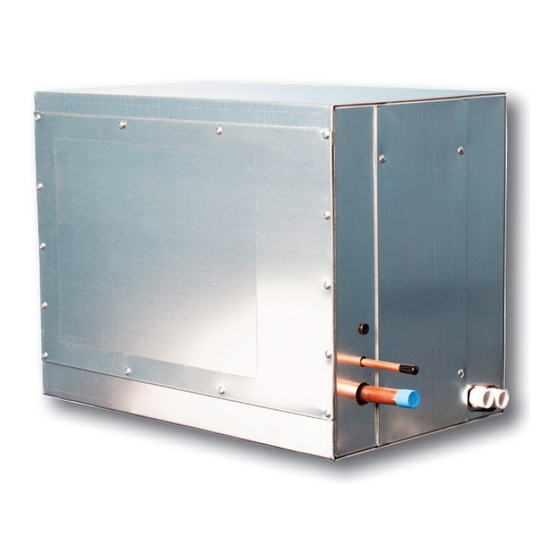Hi-Velocity 20090200050 Installatiehandleiding - Pagina 4
Blader online of download pdf Installatiehandleiding voor {categorie_naam} Hi-Velocity 20090200050. Hi-Velocity 20090200050 6 pagina's.

Pipe Sizing
When sizing refrigerant piping, follow
the outdoor unit manufacturer's
recommendations.
Piping the RPM-E
Only refrigerant grade pipe and fittings are to be used with
Hi-Velocity Systems. Plumbing fittings may contain wax or other
contaminants which are detrimental to the proper operation of
the system. Insulate the suction line with 3/8"
such as Armaflex. In high heat areas, 1/2"
may be needed. If the lines are run in an area where temperatures
could exceed 120°F
or runs longer than 50'
(49°C)
the liquid line may need to be insulated as well. Support the pipe
every 5 feet
, or whatever local code states.
(1.52m)
Run the pipes in the most direct route possible, taking into
account structural integrity and building details. If the evaporator
is located above the condenser, slope any horizontal runs toward
the condenser. If the condenser is located above the evaporator,
a P-trap must be installed at the bottom of the vertical riser. For
long vertical risers, additional P-traps must be installed for every
twenty feet
. For lines running over 50'
(6m)
accumulator must be installed. Lines running over 100'
not recommended. All lines should be piped so as not to restrict
access to the front panels, filter section, or electrical enclosure.
Brazing & Pressure Testing
The RPM-E comes pre-piped with the coil assembly. With the
RPM-E, the Liquid and Suction lines are the only brazing that
need to be done at the fan coil. For charging and brazing, remove
the front access panel of the RPM-E (Fig. RPM-06). With the
access panel removed, the coil assembly will be accessible. Wet
rag the liquid and suction line (or use a heat dissipating paste)
to ensure no overheating occurs to the pre-piped coil assembly.
Excess heat may damage the RPM-E components.
www.hi-velocity.com
insulation
(9.53mm)
insulation
(12.7mm)
, then
(15.24m)
, a suction line
(15m)
are
(30m)
Module RPM Refrigerant Module Installation (RPM-E) (3/5)
Refrigerant Module Installation (RPM-E) (3/5)
Fig. RPM-06 - Remove Front Access Panel
Once the system has been brazed it must be pressure tested.
Pressure testing must be done with nitrogen and not refrigerant.
Typically, pressures are tested to the maximum operating pressure
that the system will see. Allow the system to hold the nitrogen
charge for at least 15 minutes to ensure there are no leaks. Check
with local codes for proper testing procedures.
Evacuating
After the piping is installed and all components have been
brazed together, a vacuum pump must be used to evacuate the
system from both the low and high side to 1500 microns
. Add pressure to the system to bring the pressure above zero
pa)
psig. After allowing the refrigerant to absorb moisture, repeat the
above procedure. Evacuate the system to 500 microns
the second evacuation, and ensure that the system holds at the
vacuum pressure. If not, check for leaks and evacuate again. At
this point open service valves on pre-charged condensing units,
and add refrigerant to the system if necessary.
The use of an electronic leak detector is recommended, as it is
more sensitive to small leaks under the low pressures.
Charging
Once the system has been determined clean and ready for
charging, refrigerant can be added. The access ports on the
condenser must be open at this point. Never leave the system
unattended when charging. With the system running, slowly
add refrigerant. The typical operating point of an RPM-E coil
is that of a saturated suction temperature of 38-40°F
and a suction line temperature of 42-44°F
prevent overcharging during this stage, refrigerant should be
added in steps. This will allow time for the system to settle and
prevent 'overshooting' the ideal charge. Condenser pressures and
temperatures remain similar to those in a conventional forced air
system. It is recommended that the coil be charged on a high load
day at the compressor's highest speed.
Module RPM
(200
on
(67 pa)
(3-4°C)
. In order to
(6-7°C)
© 1995-2009 Energy Saving Products Ltd.
